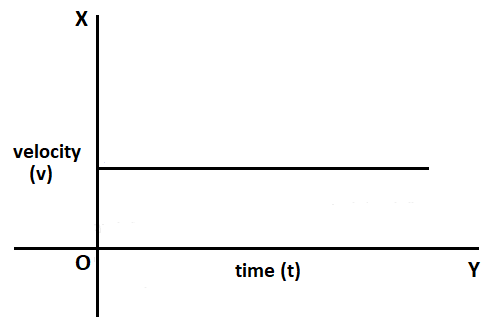
For a uniform motion,
A. the velocity – time graph is a straight line parallel to the time axis.
B. the position – time graph is a parabola.
C. The acceleration – time graph is a straight line inclined with time axis.
D. none of the above.
Answer
550.8k+ views
Hint: Objects in uniform motion travel equal displacements in equal time intervals. Objects in uniform motion do not speed up, slow down, or change direction. Now find out the graph which represents such a type of motion.
Complete step by step answer:
As we know that if a body covers equal distances in equal time intervals then it is said to move with uniform velocity and its motion is called uniform motion.
The velocity versus time (v – t) graph for a body moving with uniform speed is given as,

This graph represents that the body is in uniform motion because the velocity of the body remains constant and the body is covering equal distance in equal time interval of time.
This velocity vs. time (v – t) graph is a straight line parallel to the time (t) axis.
Hence, the correct option is A, i.e., the velocity – time graph is a straight line parallel to time axis.
Additional Information:
For representing uniform motion, if we plot a displacement (d) vs. time (t) graph then it will be a straight line inclined with time axis, which represents that the object covers equal distances in equal intervals of time.
Note: Students should understand the uniform motion and thereafter they need to know how to plot displacement vs. time graph and velocity vs. time graphs for representing the uniform motion. If the position vs. time graph is a parabola then it will represent non-uniform motion, so option B is incorrect and if the acceleration vs. time graph is a straight line inclined with time axis then it will represent increasing acceleration which is also a non-uniform motion, so option C is incorrect.
Complete step by step answer:
As we know that if a body covers equal distances in equal time intervals then it is said to move with uniform velocity and its motion is called uniform motion.
The velocity versus time (v – t) graph for a body moving with uniform speed is given as,

This graph represents that the body is in uniform motion because the velocity of the body remains constant and the body is covering equal distance in equal time interval of time.
This velocity vs. time (v – t) graph is a straight line parallel to the time (t) axis.
Hence, the correct option is A, i.e., the velocity – time graph is a straight line parallel to time axis.
Additional Information:
For representing uniform motion, if we plot a displacement (d) vs. time (t) graph then it will be a straight line inclined with time axis, which represents that the object covers equal distances in equal intervals of time.
Note: Students should understand the uniform motion and thereafter they need to know how to plot displacement vs. time graph and velocity vs. time graphs for representing the uniform motion. If the position vs. time graph is a parabola then it will represent non-uniform motion, so option B is incorrect and if the acceleration vs. time graph is a straight line inclined with time axis then it will represent increasing acceleration which is also a non-uniform motion, so option C is incorrect.
Recently Updated Pages
Class 11 Question and Answer - Your Ultimate Solutions Guide

Master Class 11 Accountancy: Engaging Questions & Answers for Success

Master Class 11 Physics: Engaging Questions & Answers for Success

Master Class 11 Business Studies: Engaging Questions & Answers for Success

Master Class 11 Maths: Engaging Questions & Answers for Success

Master Class 11 Chemistry: Engaging Questions & Answers for Success

Trending doubts
1 ton equals to A 100 kg B 1000 kg C 10 kg D 10000 class 11 physics CBSE

Difference Between Prokaryotic Cells and Eukaryotic Cells

One Metric ton is equal to kg A 10000 B 1000 C 100 class 11 physics CBSE

What is the opposite of entropy class 11 chemistry CBSE

Proton was discovered by A Thomson B Rutherford C Chadwick class 11 chemistry CBSE

1 Quintal is equal to a 110 kg b 10 kg c 100kg d 1000 class 11 physics CBSE




